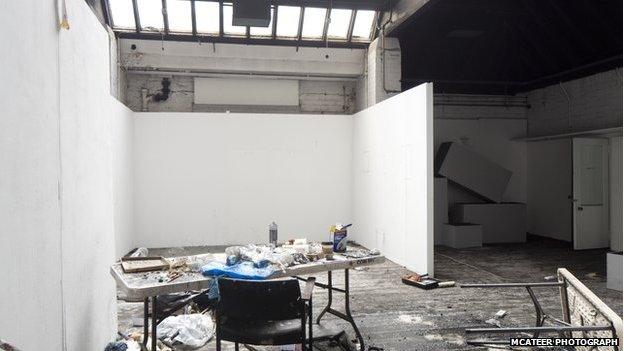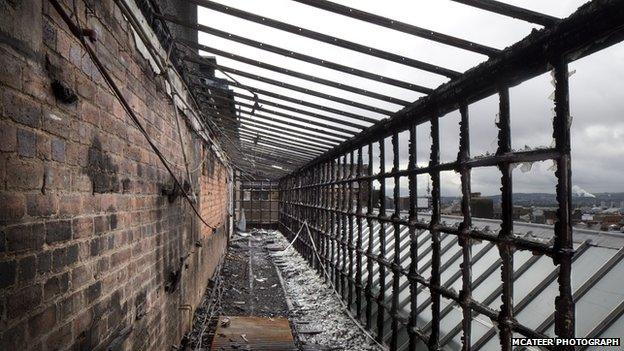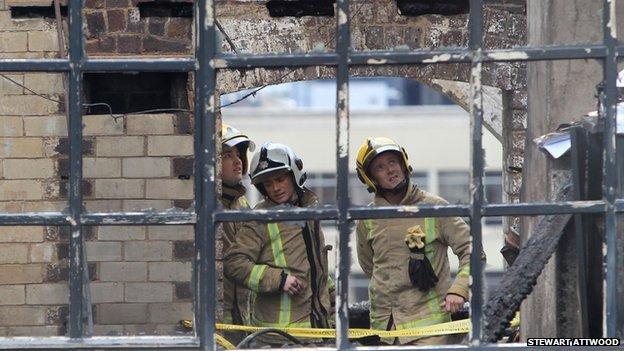Glasgow School of Art blaze: Report says foam canister caused fire
- Published

The fire was a 'horrible accident', the GSA director said
An investigation into the fire at Glasgow School of Art has concluded it was caused by flammable gases from a canister of expanding foam.
The Scottish Fire and Rescue Service (SFRS) report, external said the gases ignited as they came into contact with the hot surface of a projector in Studio 19.
Its report, compiled over six months, follows the fire on 23 May.
It said flames spread through the landmark building from the studio used by a student for an exhibition.
The student has not been named.

The fire started in a basement studio, similar to this, being used for a student's end of year exhibition
The Mackintosh building, completed in 1909, is widely regarded as the finest work built by Charles Rennie Mackintosh, Scotland's most influential architect and designer.
The report into the fire said voids in the walls and old ventilation ducts allowed the fire to take hold in neighbouring studios and spread upwards destroying the Mackintosh library, which was recognised as being one of the finest examples of art nouveau in the world.
'Horrible accident'
An improved fire protection system was being installed at the time of the blaze but was not operational, the report said.
GSA director Professor Tom Inns said the fire was a "horrible accident" and a review would seek to learn lessons from it.
He said: "Obviously there are many features in the building which contributed to the fire - those are the things that are highlighted in the report.
"So we need to think about, as we go into the restoration process for the building, what things we need to take on board, what lessons we can learn from that, in terms of how we bring the building back."
He said that also applied to the east wing of the building, which was not damaged by the fire, but which has the same design features as the west section where the blaze took hold.

Ventilation ducts allowed the fire to spread from the basement to the roof
An appeal has been launched to raise £20m for the restoration of the historic building - but some observers believe the eventual cost could be as high as £35m.
The report said the fire started in Studio 19 in the north basement, west wing of the Mackintosh Building.
A student exhibition space made from chipboard and wooden studs had been constructed there.
It consisted of high expansion foam panels fastened to three of the walls, with one wall left blank to receive projected images from a projector mounted on the opposite wall.
At the time of the incident gaps between the foam panels were being filled-in by applying foam directly from a canister of expanding foam.
The report said: "Fire was caused when flammable gases (isobutane, propane and dimethyl ether) used as a propellant within a canister of expanding foam was discharged in close proximity to the projector.
"These flammable gases were drawn into the projector cooling fan."
The SFRS said the projector was not defective but added: "It is likely indirect ignition of the flammable gases occurred as it passed in and around energised electrical components of the projector.
"Once ignited, the flame front would have grown in size consuming plastic components and the plastic casing of the projector, flames then impinged onto the foam which was placed on the wall directly behind it."
Projector
The report said the design of the building contributed to the spread of the fire.
"A major contributory factor for the fire spreading throughout the building was the number of timber-lined walls and voids, and original ventilation ducts running both vertically and horizontally throughout the building," it said.
It said: "A vertical service void ran the entire height of the building to roof level and acted like a chimney. It allowed flames, hot gases and smoke to travel vertically."

Firefighters have been praised for saving a significant part of the building, including collections and archives
GSA said information from the SFRS Fire Report will be used to inform the Mackintosh Building restoration and GSA's broader approach to health and safety management.
But it restated its thanks to SFRS for its work to save a significant part of the Mackintosh Building, its collections, archives and the work of staff and students.
A statement said: "Progress is being made on plans for the restoration of the Mackintosh Building.
"The building is now wind and water tight, is being cleared with services being reinstated to allow works to commence.
"And specialists from Kirkdale Archaeology are forensically excavating the remains of the Mackintosh Library, the outcomes of which will inform the restoration."
It aims to have the building fully restored and operational as a working art school, exhibition space and visitor attraction between 2018 and 2019.